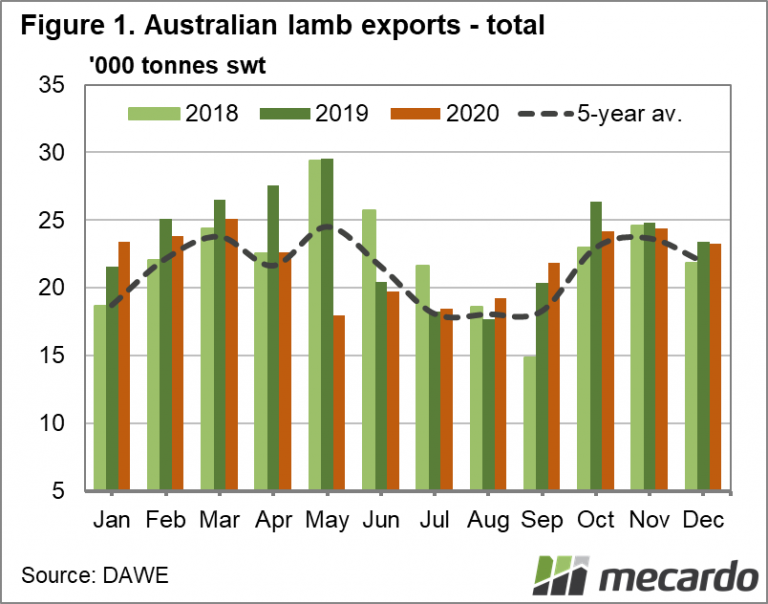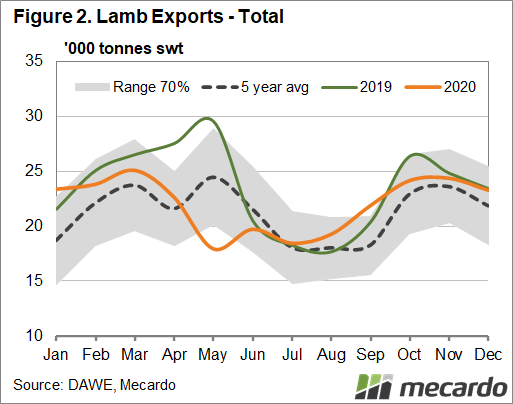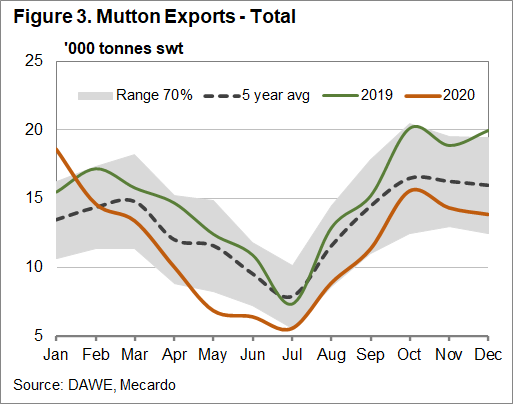The annual Australian Lamb summer campaign launched the industry’s domestic marketing campaign for 2021 and so far seems to have hit the right note with consumers. Domestic consumption remains the most prominent market for Australian lamb, with roughly 40 per cent of production staying in the country. Aussies spent about $2 billion on lamb in 2018-19, according to Meat & Livestock Australia, consuming nearly 7kg of sheepmeat each.
But with the weighted average lamb saleyard price reaching 807¢/kg for the 2019-20 year, it is no wonder the Australian retail lamb price was averaging a record $18.28¢/kg for 2020 (latest data September). And as much of the government assistance to offset the economic impacts of Covid-19 begins to disappear, there is likely to be a push-back on retail price this year, leading to lower consumption.
Looking overseas, lamb export volumes recovered in the second half of 2020, and as you can see in Figure 1, they spent the last six months above the five-year-average. This equated to the annual total lamb export volume only dropping 6% for 2020 compared to 2019- not much at all when you consider sheep saleyard throughput was down 14%, and ABARES is forecasting lamb production to be down 7% for the 2020-21 period.
China took 11% less lamb in 2020 (compared to 2019) but still made up 24% of the market (down from 25% the year prior), while the US increased the volume of Australian lamb they imported by 4%, taking their market share up to 23%. This share of the market was lost by the Middle East, who dropped to 20% (from 23% in 2019), taking close to 14,000 tonnes less, mainly due to the lack of airfreight availability.
What does it mean?
The Eastern States Trade Lamb Indicator has opened this week at 873¢/kg, up nearly 150¢/kg on the same time last year – which was before some much improved seasonal conditions in sheep producing parts of the country, but also before many people had heard of Covid-19. The strength of the lamb market as we head into 2021 will depend on how quickly the rainfall was turned into ewes in the paddock (and therefore lambs on the ground) and how hard Covid-19 continues to bite – both here and internationally. Economic downturn is a given, but the flock-rebuild phase, teamed with a focus on reliable, secure, and clean food source by many countries, could be enough to keep prices historically strong.
Have any questions or comments?
Key Points
- Lamb exports finish 2020 above the five-year average, recovering strongly in the final half of the year.
- Mutton exports feel supply and Covid-19 pinch, dropping to their lowest levels since 2016.
- Domestic lamb consumption still some of the highest in the world, but retail price point could start to bite.
Click on figure to expand
Click on figure to expand
Click on figure to expand
Data sources: MLA, ABARES, Mecardo




